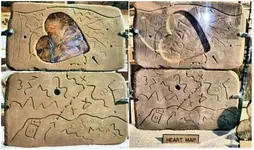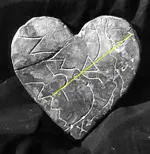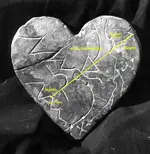Oroblanco
Gold Member
- Joined
- Jan 21, 2005
- Messages
- 7,841
- Reaction score
- 9,876
- Golden Thread
- 0
- Location
- DAKOTA TERRITORY
- Detector(s) used
- Tesoro Lobo Supertraq, (95%) Garrett Scorpion (5%)
Roy,
The Four Peaks are shown on the Stone Maps. It's a representation as seen from the ridge, thus not in the exact location on the stones.
The only way you know where Weaver's Needle is on the Stone Map Trail is to know the landmarks/canyons/trails all around it. That really takes time in the mountains to see it.
I will be happy to sit down at the Rendezvous to explain it and answer any questions......best I can. I'm not so interested as I once was.
We are looking forward to seeing you and Beth as well.
Take care,
Joe
Well, I am not convinced that saw-tooth marking really represents 4 Peaks. You even have stated one of the major issues with saying that is 4 Peaks - quote "not in the exact location on the stones" unquote; considering how well your solution to the map fits with the USGS topo, why should 4 Peaks be SO screwed up in location? That does not make sense to me.
I have read and heard many arguments to prove the stone maps must go to the Superstitions, but have never found these arguments convincing. The stone maps have many clear markings on them yet nothing for Weavers Needle, or Four Peaks (arguably of course) even though these are two of the principal landmarks of the region, visible for miles? Must be I have not spent enough time in the mountains to see it.
I have NO intention of eating up your Rendezvous time forcing you to try to re-explain the whole thing to someone as thick skulled as I am, really until someone has absolute proof that cannot be debated I will probably remain un-convinced that the stone maps MUST go to the Superstitions. As a side note here but did you ever see the Dillmans' solution to the stone maps, and how well it will fit for their spot in Utah? I am far from convinced that is "The" answer either, for by their solution those eighteen holes are much more than a days travel apart, which would not make much sense.
BTW those eighteen holes are really an ancient Golf Course; it was considered "The" most difficult golf course in all of Scotland, for you had to have an "in" with Henry Sinclair even to be allowed on one of his ships to get to America, and then the long and difficult hike to the Superstitions weeded out all but the very toughest Scot golfers. Par was considered to be 388, though that is purely hearsay, and people have been 'fudging' their golf scores even since the 1300s when Henry was around. Only the highest ranking Freemasons were allowed even to know about the secret Superstitions golf range, and this was the root of the name Superstitions too according to my (unpublished) source.

Sorry about that, could not resist - and Joe if you would like to go over the stone maps again I won't throw a hissy fit.
Oroblanco










 np
np


